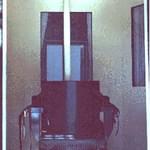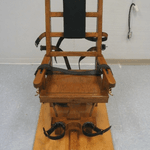

Lethal injection is the most widely-used method of execution, but many states authorize other methods including electrocution, lethal gas, and firing squad.
The primary means of execution in the U.S. have been hanging, electrocution, the gas chamber, firing squad, and lethal injection. The Supreme Court has never found a method of execution to be unconstitutional, though some methods have been declared unconstitutional by state courts. The predominance of lethal injection as the preferred means of execution in all states in the modern era may have put off any judgment by the Court regarding older methods.
Because of a resistance by drug manufacturers to provide the drugs typically used in lethal injections, some states now allow the use of alternative methods if lethal injection cannot be performed. Controversies surrounding the method to be used have delayed executions in many states, contributing to an overall decline in the use of the death penalty.
NOTE: [Brackets] around a state indicate that the state authorizes the listed method as an alternative method if other methods are found to be unconstitutional or are unavailable/impractical. Click on the state to obtain specific information about the methods authorized.
28 states + and U.S. Military and U.S. Gov’t
In South Carolina, lethal injection may be elected as an alternative method, if available.
+ includes 1 state that no longer have an active death penalty
Alabama, Arizona, Arkansas, California, Florida^, Georgia, Idaho, Indiana, Kansas, Kentucky, Louisiana, Mississippi, Missouri, Montana, Nebraska, Nevada, New Hampshire*, North Carolina, Ohio, Oklahoma, Oregon, Pennsylvania, [South Carolina], South Dakota, Tennessee^, Texas, Utah, Wyoming, U.S. Military, U.S. Government
*New Hampshire abolished the death penalty but the repeal may not apply retroactively, leaving a prisoner on death row facing possible execution.
[Alabama], [Arkansas], Florida, Kentucky, [Louisiana], [Mississippi], [Oklahoma], South Carolina, [Tennessee]
The supreme courts of Georgia (2001) and Nebraska (2008) have ruled that the use of the electric chair violates their state constitutional prohibitions against cruel and unusual punishment.
Virginia had authorized the electric chair as a method of execution in some cases, but it repealed the death penalty in March 2021.
[Alabama], Arizona, California, [Louisiana], [Mississippi], Missouri, [Oklahoma], [Wyoming]
Four states (Alabama, Louisiana, Mississippi, and Oklahoma) specifically authorize execution by nitrogen hypoxia, though only Alabama has issued a protocol for its use. Alabama is the only state that has performed an execution by nitrogen hypoxia. The other states listed authorize “lethal gas,” but do not specify what type of gas would be used.
^Both Florida and Tennessee explicitly authorize lethal injection and electrocution, but state that, if those methods are found unconstitutional, prisoners may be executed by any constitutional method of execution.

In an August 31 , 2024 , editorial from The New York Times, the newspaper’s editorial board writes that capital punishment is “ immoral, unconstitutional and useless as a deterrent to crime,” and asserts that President Joseph Biden should follow through with his campaign pledge to end the federal death penalty. The Times believes “ it would be an appropriate and humane finale to his presidency for Mr. Biden to fulfill that pledge and try to eliminate the death penalty for federal…
On April 16 , 2024 , the Louisiana Senate Judiciary B Committee unanimously voted to advance a bill that would remove nitrogen hypoxia from the state’s available methods of execution. Introduced by state Senator Katrina Jackson-Andrews, Senate Bill 430 is supported by the Jews Against Gassing Coalition, an organization consisting of Jewish Louisiana residents who oppose state-sanctioned gas executions. “ We recognize, of course, that the gassing of innocent victims in the Holocaust is quite…

As more states consider nitrogen hypoxia as an execution method, three of the largest manufacturers in the U.S. have barred their products intended for life-saving measures from use in…

In May 1990 , Jonathan Eig, then a reporter for The New Orleans Times-Picayune, witnessed the electric-chair-execution of Dalton Prejean at Angola State Penitentiary for the 1977 murder of a Louisiana state trooper. Mr. Eig watched Mr. Prejean’s execution through an observation window, and reported seeing “ his chest heave, his fists clench and his right wrist twist outward. A spark and a puff of smoke shot from the electrode attached to his left leg.” In the years following the execution, Mr.

Thomas Creech’s February 28 execution was halted after the Idaho Department of Correction execution team was unable to set an intravenous line after an hour of repeated attempts. Mr. Creech remained strapped to the gurney and conscious while unsuccessful attempts were made to access veins in both arms and legs. Officials did not disclose why the execution team was unable to establish an IV line, but the training and qualifications of staff, as well as the accessibility and quality of Mr.


Links to state execution protocols, status, and secrecy policies
The Daily Intelligencer has collected pictures of execution chambers around the country (May 16 , 2014 ).
Autopsy photos of a botched lethal-injection execution in Florida (New Republic May 29 , 2014 ). (Warning: graphic images).
Some legislators have advocated for a return to the electric chair as a mandatory method of execution because of the difficulty in finding lethal injection drugs. See pictures in the aftermath of Florida’s last electrocution of Allen Davis in 1999 (Warning: graphic images).
“ They ought to just bring back the firing squad — I don’t care. If they’re going to have a death penalty in Ohio, they should carry it out. And if you don’t want it, get rid of it. That’s fine with me.”
— Joe Deters, Hamilton County ( OH ) Prosecutor, who has sought the death penalty 120 times
Ohio Public Radio, Nov. 1 , 2013
Listen to the audio “ Execution Tapes” recorded by the Georgia Department of Corrections, which narrate the executions of 22 inmates in the electric chair. (photo below: Florida’s Electric Chair/Doug Magee)